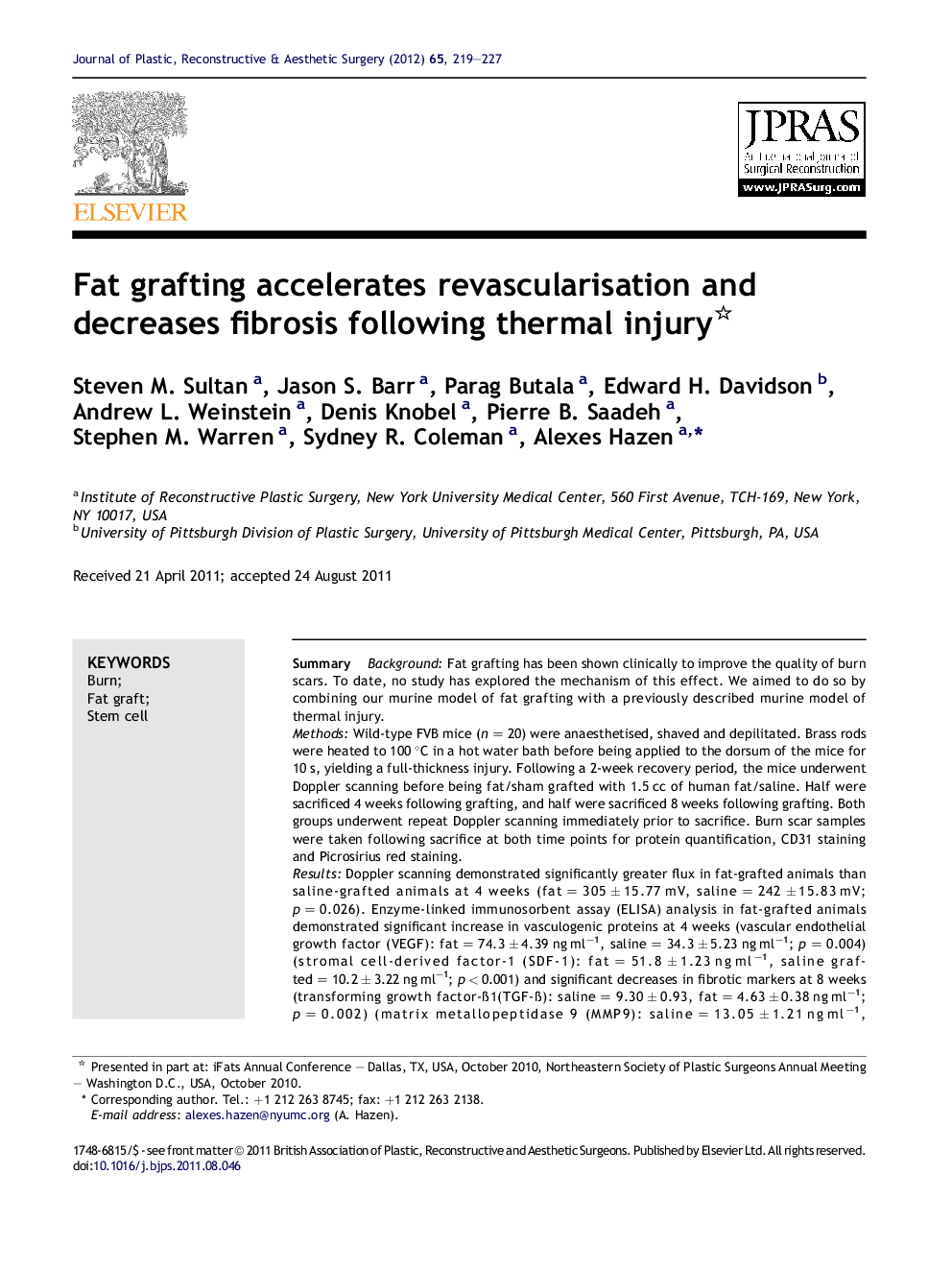| کد مقاله | کد نشریه | سال انتشار | مقاله انگلیسی | نسخه تمام متن |
|---|---|---|---|---|
| 4118684 | 1270337 | 2012 | 9 صفحه PDF | دانلود رایگان |

SummaryBackgroundFat grafting has been shown clinically to improve the quality of burn scars. To date, no study has explored the mechanism of this effect. We aimed to do so by combining our murine model of fat grafting with a previously described murine model of thermal injury.MethodsWild-type FVB mice (n = 20) were anaesthetised, shaved and depilitated. Brass rods were heated to 100 °C in a hot water bath before being applied to the dorsum of the mice for 10 s, yielding a full-thickness injury. Following a 2-week recovery period, the mice underwent Doppler scanning before being fat/sham grafted with 1.5 cc of human fat/saline. Half were sacrificed 4 weeks following grafting, and half were sacrificed 8 weeks following grafting. Both groups underwent repeat Doppler scanning immediately prior to sacrifice. Burn scar samples were taken following sacrifice at both time points for protein quantification, CD31 staining and Picrosirius red staining.ResultsDoppler scanning demonstrated significantly greater flux in fat-grafted animals than saline-grafted animals at 4 weeks (fat = 305 ± 15.77 mV, saline = 242 ± 15.83 mV; p = 0.026). Enzyme-linked immunosorbent assay (ELISA) analysis in fat-grafted animals demonstrated significant increase in vasculogenic proteins at 4 weeks (vascular endothelial growth factor (VEGF): fat = 74.3 ± 4.39 ng ml–1, saline = 34.3 ± 5.23 ng ml–1; p = 0.004) (stromal cell-derived factor-1 (SDF-1): fat = 51.8 ± 1.23 ng ml–1, saline grafted = 10.2 ± 3.22 ng ml–1; p < 0.001) and significant decreases in fibrotic markers at 8 weeks (transforming growth factor-ß1(TGF-ß): saline = 9.30 ± 0.93, fat = 4.63 ± 0.38 ng ml–1; p = 0.002) (matrix metallopeptidase 9 (MMP9): saline = 13.05 ± 1.21 ng ml–1, fat = 6.83 ± 1.39 ng ml–1; p = 0.010). CD31 staining demonstrated significantly up-regulated vascularity at 4 weeks in fat-grafted animals (fat = 30.8 ± 3.39 vessels per high power field (hpf), saline = 20.0 ± 0.91 vessels per high power field (hpf); p = 0.029). Sirius red staining demonstrated significantly reduced scar index in fat-grafted animals at 8 weeks (fat = 0.69 ± 0.10, saline = 2.03 ± 0.53; p = 0.046).ConclusionsFat grafting resulted in more rapid revascularisation at the burn site as measured by laser Doppler flow, CD31 staining and chemical markers of angiogenesis. In turn, this resulted in decreased fibrosis as measured by Sirius red staining and chemical markers.
Journal: Journal of Plastic, Reconstructive & Aesthetic Surgery - Volume 65, Issue 2, February 2012, Pages 219–227